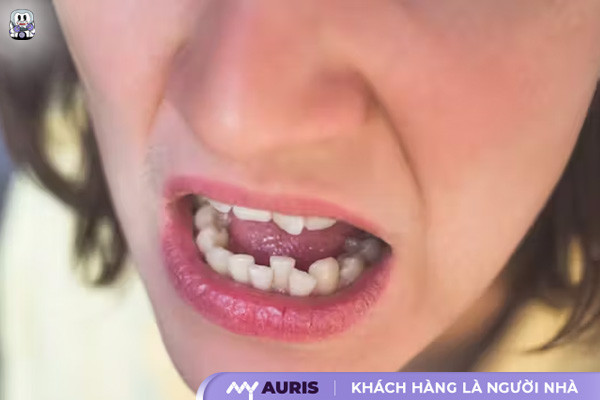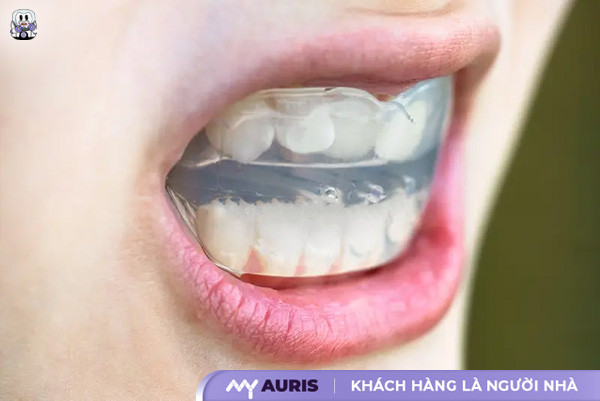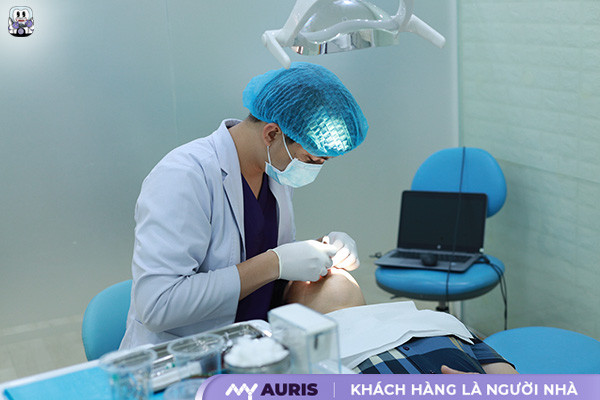Home remedies to straighten teeth without braces are suitable for individuals with slight dental misalignment who wish to improve aesthetics without high costs. You can apply simple methods such as adjusting tongue posture, performing jaw muscle exercises, or using a trainer aligner if done regularly and with correct technique.
5 Effective Ways to Straighten Teeth at Home Without Braces
Straightening teeth at home without braces is becoming a popular choice for many, especially those who want to improve their smile without medical intervention. Below are 5 simple, effective methods if you are persistent and apply the correct techniques.

Correct Tongue Posture
Correct tongue posture helps shape the facial bone structure and dental arch in the right direction. This is the foundation of the mewing method, where the tip of the tongue always rests against the roof of the mouth. Maintaining correct tongue posture creates gentle, consistent pressure, helping teeth gradually move into their proper positions on the dental arch.
How to perform:
- Keep your mouth naturally closed.
- Press your entire tongue against the roof of your mouth, not just the tip.
- Try to breathe through your nose to maintain this posture continuously.
Practicing for at least 30 minutes per session, 3–4 times/day, will help improve your teeth over time.
Jaw Muscle Exercises
Strong jaw muscles keep teeth in stable positions, preventing crookedness or misalignment due to uneven chewing forces. Jaw muscle exercises help improve coordination between facial and jaw muscles, contributing to straighter teeth.
Simple exercises:
- Gently hold a small object like a straw between your teeth for 10–15 minutes daily.
- Chew sugar-free gum on both sides of your jaw to increase balance.
- Read vowels A – E – I – O – U aloud, keeping your mouth wide and even.
Maintaining these exercises for 4–6 weeks will help you feel a stronger and more balanced jaw force.

Using a Trainer Device for Gentle Correction
A trainer is a soft plastic aligner that helps shape tooth positions with gentle pressure while worn. This type of device is suitable for adolescents or individuals with slight tooth misalignment.
How to use:
- Wear for 1–2 hours daily or while sleeping.
- Clean thoroughly after each use and replace the aligner every 2–3 months.
- Use according to the seller’s instructions or consult a dental professional.
Costs range from 150,000 – 600,000 VND, making it suitable for young people who cannot afford specialized braces.
Massaging Gums and Teeth to Encourage Natural Correction
Gum massage aids blood circulation and gently influences misaligned teeth, thereby increasing the teeth’s ability to self-correct. Additionally, massaging the cheek area also impacts facial muscle structure.
How to perform:
- Using clean fingers, massage around the gums in a circular motion for 2–3 minutes on each side.
- A water flosser or soft toothbrush can be used to enhance effectiveness.
- Perform after brushing your teeth in the morning and evening.
This method is highly supportive when combined with other techniques.

Maintain Proper Mouth Posture and Oral Hygiene
Mouth posture affects tooth eruption direction, especially during development. Always keeping your lips closed, not breathing through your mouth, holding your chin straight, and not resting your hand on your face will help limit tooth misalignment.
Furthermore, proper oral hygiene prevents tooth decay and tooth loss – causes of remaining teeth shifting out of place.
- Brush your teeth at least twice a day.
- Use dental floss instead of toothpicks.
- Visit the dentist every 6 months for early detection of misalignment.
Why Do Many People Want Straight Teeth Without Braces?
They hope for home-based methods to straighten teeth without braces, using simple techniques like jaw muscle exercises, adjusting tongue posture, or wearing at-home teeth-straightening devices. These methods are suitable for individuals with slight tooth misalignment, are pain-free, inexpensive, and can be performed autonomously.
This trend is increasingly popular because:
Affordable and accessible
The cost of supportive appliances such as aligners, tooth trainers, ranges from 150,000 to 600,000 VND. Compared to investing in fixed braces, this is a price most users can accept. Moreover, many oral muscle exercises or “mewing” techniques are entirely free, requiring only daily consistency.
Pain-free, no medical intervention required
Unlike braces, which involve attaching fixed appliances to teeth, home methods such as gum massage, jaw muscle exercises, or adjusting tongue posture are completely non-invasive. They help straighten teeth through natural forces and gradual changes in facial bone structure.
Flexible time and space
You can perform these methods at home at any time. There’s no need for frequent dental visits, travel, or follow-up appointments, making it a suitable choice for busy individuals or those living far from urban centers.
Suitable for young individuals whose teeth are not yet fully fixed
In adolescence and young adults under 25, teeth and jaw structures can still change with daily habits. Timely intervention with jaw muscle exercises and proper tongue posture can effectively adjust tooth positions without requiring intervention from a dentist.
Information spread from the online community
Trends like mewing, hard object biting exercises, or wearing teeth aligners are widely shared on social media, sparking curiosity and adoption among many. Some users have achieved significant improvements, further spreading belief in natural teeth-straightening methods.

Common Causes of Uneven Teeth Eruption
Before applying home methods to straighten teeth without braces, you need to understand the causes of misaligned teeth to choose the appropriate method and avoid repeating old mistakes.
Pressure from Bad Childhood Habits
One of the common causes is habits like tongue thrusting, thumb sucking, or prolonged pacifier use. These behaviors create incorrect forces on the teeth and jawbone, especially the front teeth. When the tongue constantly pushes forward, the teeth will gradually shift out of the dental arch, leading to overbites, underbites, or gaps.
To remedy this, jaw muscle exercises and the mewing technique can be applied – a method that guides correct tongue posture by pressing the tongue against the roof of the mouth, supporting stable jaw structure and tooth eruption direction.
Genetics and Facial Bone Structure
Genetic factors are unchangeable. If parents have narrow mouths, crowded teeth, or a misaligned dental arch, children have a high risk of inheriting these traits. Additionally, facial bone structure changes with age can also affect tooth alignment. In some cases, uneven jawbone development between the two sides causes jaw deviation, leading to uneven tooth eruption.
Early Loss of Primary Teeth or Delayed Eruption of Permanent Teeth
If primary teeth fall out too early, the remaining teeth tend to shift to fill the gap. This leaves insufficient space for permanent teeth to erupt, leading to crowding or crookedness. Conversely, if permanent teeth are slow to erupt, surrounding teeth may occupy the wrong position, causing the eruption process to deviate from the correct axis.
Uneven Chewing Force and Incorrect Oral Muscle Posture
Few people realize that chewing on one side, habitually chewing with only one side of the jaw, or sleeping on one side for extended periods can also create an imbalance in the oral system. Over time, this weakens one side of the jaw muscles while strengthening the other, leading to teeth shifting, slight jaw rotation, and asymmetry.
The solution is to improve daily habits: chew evenly on both sides, change sleeping posture, and perform jaw muscle exercises to restore balance.
Impact of Oral Diseases
Tooth decay, gum inflammation, and unaddressed tooth loss can also cause teeth to shift. When a tooth is lost, adjacent teeth tend to lean into the empty space, disrupting the alignment of the teeth.
Maintaining good daily oral hygiene, combined with gum massage, helps limit abnormal tooth movement.
Common Mistakes That Prevent Tooth Improvement
Seemingly harmless habits can actually worsen misaligned, crooked, or gapped teeth:
Not Maintaining Correct Tongue Posture
Tongue posture plays a crucial role in maintaining facial bone structure and tooth position on the dental arch. Many people overlook this principle, leading to unnoticed tooth misalignment. The correct posture is to press the tongue against the roof of the mouth, not touching the teeth, with lips gently closed. A small action, yet it significantly impacts the entire oral system.
Overusing Unverified Teeth-Straightening Devices
Some people use aligners or trainer devices bought online without controlling the applied force. Incorrect use can cause pain, misalign the bite, or further shift teeth. There have been many cases of gum and jaw muscle damage due to wearing them for incorrect durations or choosing the wrong size.
Inconsistent Oral Muscle Exercises or Incorrect Technique
Jaw muscle exercises and tongue thrusting techniques (mewing) require regular practice. Many people practice incorrectly or stop midway, preventing sustained tooth alignment. Some even exert too much force, causing jawbone pain.
Not Maintaining Thorough Oral Hygiene
Some people focus solely on teeth straightening but forget that maintaining oral hygiene is a fundamental factor. When teeth suffer from decay, gum inflammation, or tooth loss, the remaining teeth can shift or become unstable. This is why many cases, despite correct practice, show no improvement.
Overly High Expectations for Home Methods
Some people expect immediate results after just a few weeks of applying home teeth-straightening methods without braces. In reality, these methods offer only mild to moderate effectiveness and depend heavily on age, dental condition, and persistence.
Notes When Straightening Teeth at Home
Slightly crooked teeth, mild overbites, small gaps, or minor misalignments are cases that can be improved with home methods. If you have severe crowding, malocclusion (incorrect bite), or overall jaw misalignment, you should consult a dentist. Self-intervention in such cases can further distort the facial bone structure and dental arch.
Natural teeth-straightening methods like mewing, jaw muscle exercises, wearing trainers, or adjusting tongue posture do not yield immediate results. You need 3–6 months to see noticeable changes. This method is painless and non-invasive but requires high levels of patience and personal discipline.
Dental trainers, removable orthodontic aligners, or gentle correction devices must be used according to instructions. Do not choose unverified products or wear them for excessively long periods daily. Everyone has different tooth and mouth structures. Mechanical application without proper guidance can lead to further tooth misalignment.
Tongue posture directly affects the pressure on teeth. Practice pressing the tip of your tongue against the roof of your mouth, with lips slightly closed, and without pushing your teeth with your lips. Maintaining this posture helps the jaw develop in the correct direction, creating a foundation for a balanced oral system.
During the process of self-straightening teeth at home, thorough hygiene is mandatory. Food debris stuck to teeth can cause tooth decay, gum inflammation, and reduce the effectiveness of correction. Brushing correctly, using dental floss, and rinsing daily are essential to maintain.
Even without visiting a dentist, you should monitor changes through photos or by feeling your bite. If after 2–3 months there are no signs of improvement or if teeth tend to shift further, stop and seek advice from a dentist. This helps prevent undesirable complications.
This method does not completely replace braces. It is suitable for young individuals whose jawbones are still developing, or for cases of minor misalignment. Adults or those with severe misalignment should consider carefully. Expecting perfectly straight teeth solely through jaw muscle exercises and mewing is unrealistic.

When to See a Dentist Instead of Self-Correcting?
There are signs indicating that you should see a dentist instead of continuing self-correction at home:
Severe misalignment or serious crowding
If you notice an unbalanced facial bone structure, excessively overlapping front or canine teeth, or severe crowding, these cannot be improved simply by correct tongue placement or jaw muscle exercises. Techniques like the mewing trend or dental trainer devices only exert gentle pressure on tooth positions, which is insufficient to correct severely crooked teeth. In such cases, cosmetic braces or specialized orthodontic intervention are necessary.
Malocclusion or difficulty chewing
An incorrect bite is a major factor affecting the oral system and overall health. If you experience jaw fatigue, weak jaw muscles, temporal headaches, or your upper and lower jaws don’t align when biting, it’s time to visit the dentist for an examination. Malocclusion can lead to many consequences such as underbites, overbites, or gapped teeth, and cannot be improved by at-home teeth-straightening exercises.
No improvement after 3 to 6 months of practice
Home teeth-straightening methods such as wearing aligners, practicing biting on hard objects, or gum massage typically require a minimum of 3 months for initial results. If after 6 months of continuous application, your teeth’s alignment hasn’t changed, or teeth remain misaligned, it indicates that your condition is beyond the scope of natural methods. You should seek early dental examination to prevent further tooth misalignment over time.
Tooth loss, decay, or prolonged gum inflammation
A mouth with decayed teeth, long-term tooth loss, or untreated gum inflammation will lead to abnormal shifting of the remaining teeth. In these cases, at-home teeth correction is ineffective and may even worsen tooth misalignment. A dentist will assess the misalignment of the front teeth or the entire arch and provide an appropriate treatment plan.
Children showing signs of maxillofacial misalignment
During developmental age, teeth and jawbone structures change rapidly. If a child shows signs of crooked teeth, overbite, underbite, or unclear speech due to malocclusion, an orthodontist should be consulted early. Removable orthodontic appliances or dental aligners will help guide development more safely and effectively than at-home oral muscle exercises.





